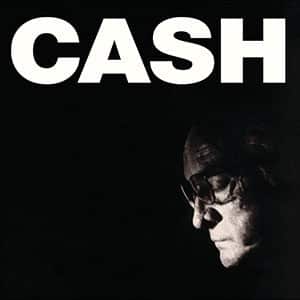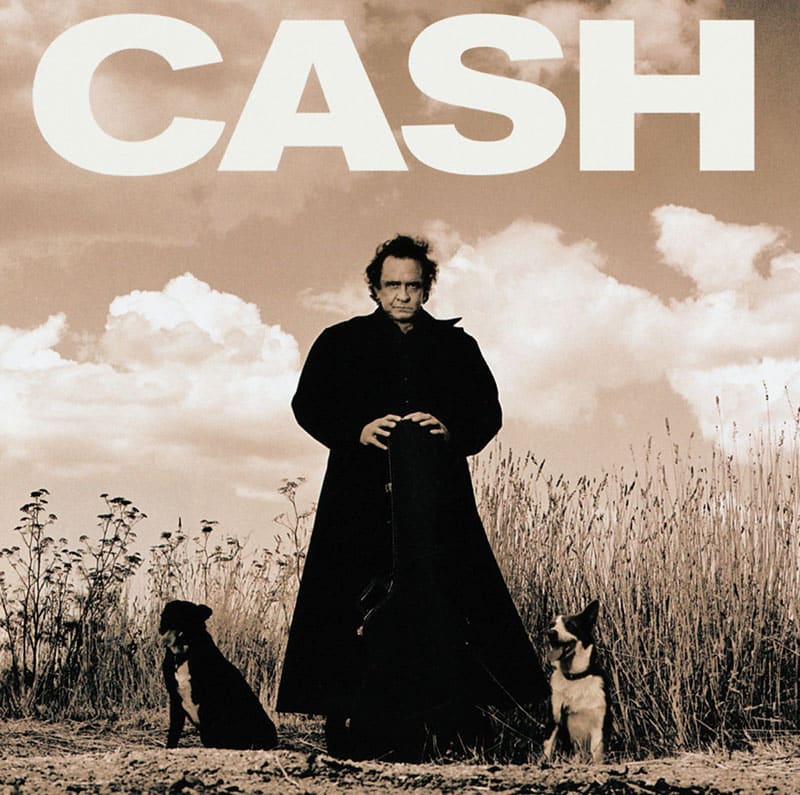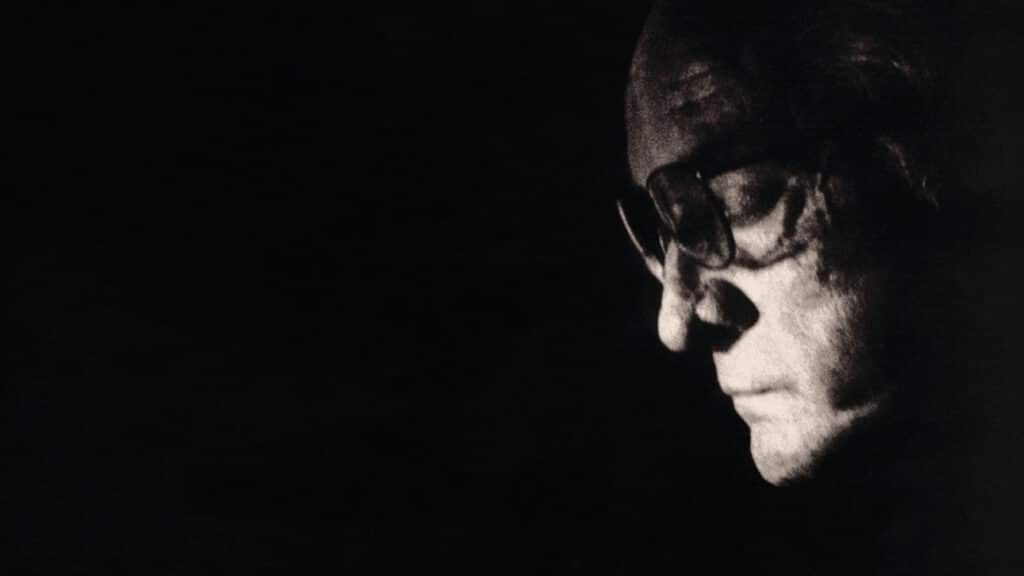
The partnership between Johnny Cash and Rick Rubin seems strange, but the collaboration between the Man in Black and the guy who rose to fame producing albums from Slayer and the Beastie Boys reinvented one of America’s original badasses.
Their collaboration produced six albums and a boxed set, some of Johnny Cash’s best work since his early music for Sun Records in the 1950s. The 2002 album American IV: The Man Comes Around was the final album released while Cash was alive and is a fitting, albeit flawed, capstone to the American project. It contains some of the best and most crucial work Cash did in decades, but it captures his rapidly declining health and includes a few tracks that don’t quite work.
The story arc of the American Recordings is a redemption tale for Johnny Cash, but before we zoom in on American IV, let’s set the stage by talking about the path that led to Cash’s career hitting rock bottom.
Cash was a country music legend and one of rock ‘n’ roll’s founding fathers from his days at Sun Records. Despite making records, movies, and television shows for years, his career was on the ropes by the mid-1990s. He had lost his edge, and the country music establishment – including his record label – no longer cared what he had to say. Cash’s long-time label, Columbia Records, dropped him in 1986, and his new home at Mercury didn’t give him much support. Much of the music he recorded in the 1980s had layers of thin-sounding production over it, like cellophane. His career was so on the ropes that he was parodying himself in ridiculous songs like “The Chicken in Black”. The badassery upon which he had built his career was gone.
Rubin had to sell Cash on the prospect of working together, and, more importantly, he had to convince Cash to believe in himself. The results were some of the best music of his career. The overall body of work is impressive, and you’d be hard-pressed to find an artist who had that big of a gap between periods of making important music.
The first American Recordings album stunned critics with its stark honesty. Cash had never recorded a solo acoustic album before, but it received a five-star review from Rolling Stone after the magazine hadn’t even bothered reviewing one of his albums for almost 20 years. Randy Lewis from the Los Angeles Times compared the album to the western film Unforgiven.
The first album got rave reviews when it came out in 1994, but the mass appeal was a slow roll as the project went on, and Cash’s path back did not go through the country music world. Cash sarcastically “thanked” the country music establishment for their support with a full-page photograph of him giving the middle finger.
Johnny Cash’s Failing Health
Johnny Cash’s health problems started to show up during the recording sessions of the second album, Unchained, and he was very ill by the time he started working on American IV. He suffered from autonomic neuropathy and was frequently in the hospital with many problems. Cash was almost blind and spent a lot of time in a wheelchair. As such, he could not travel, so Rubin had engineer David Ferguson set up recording equipment at Cash’s cabin in Henderson, Tennessee. In “Controversy: Johnny Cash vs. Music Row” on CMT, Ferguson estimated that there were times when Cash canceled up to 80 percent of the recording sessions because he was so ill.
You can hear his age and illness in his voice in these songs. His famous oaken baritone voice is still there, but there are cracks. Some of the “S” sounds in the songs have a slight slur that starts to show up with age. Cash’s team had been splicing together verses from different takes since the second record, but by now, they were splicing together lines from different versions. He was so ill that they were mining takes like that for anything that worked.
Cash’s health is also reflected in the album artwork. Look at the cover of the first American Recordings album: Cash is older but defiant looking. The camera looks slightly up at him as he’s wearing a duster, flanked by two dogs. It’s the American badass in his second career.
Compare that to the cover of American IV. It still has CASH written across the top in all capital letters, but the front is all black except for a sparse light illuminating Cash’s face from the bottom. He’s looking down with his eyes closed and wearing glasses. It looks like he’s deep in thought or even praying.
The Power of “When the Man Comes Around” and “Hurt”
Like the rest of the American albums, the fourth installment is a mix of original songs and covers. The only new original track is the opening title cut, “When the Man Comes Around”, about the end of days. It’s a great tune that still holds up today, and it’s an appropriate topic for the Man in Black. Johnny Cash was religious, and the Bible ducked in and out of his music for decades.
The song opens with Cash reading from the book of Revelations, and it’s brimming with religious imagery without actually naming Jesus. Musically, it’s faster and busier than much of the American sessions’ music. The fast-played acoustic guitar gets the track close to the boom-chicka-boom sound Cash and the Tennessee Two made famous. In the fantastic biography Johnny Cash: A Life, Robert Hilburn mentions that the guitar on the song is the same Fender Esquire that Luther Perkins played while recording with Cash at Sun Records.
Hilburn’s book continues that Cash’s son, John Carter Cash, called it “the most important thing he had written, maybe ever, and he just loved it”. Meanwhile, Marty Stuart said the song was “the most strangely marvelous, wonderful, gothic, mysterious, Christian thing that only God and Johnny Cash could create together.”
While it’s a great song, the one that hangs over American IV – and this part of Cash’s career – is the cover of “Hurt” from Nine Inch Nails. As towering an achievement as it was, it was an uphill fight to get it recorded. Rubin knew Cash could grab hold of a song with two hands and yank it into his world. He could strip down a track and run it through the furnace of his life before putting the newly tempered version onto a record. Rubin also saw the potential in other people’s songs once Johnny Cash got hold of them. Reading that Johnny Cash covered “Rusty Cage” by Soundgarden sounds weird on the surface, but listen to it, and you’ll realize that it works.

Rubin saw that potential in “Hurt” from Nine Inch Nails, but it took a while to get Cash on board. Rubin suggested the song to him at least three times, and the last time, Rubin – who isn’t a musician – banged out a very rough and basic version on an acoustic guitar to show Cash what the song could do in his hands. “I played him the song first, and Johnny just looked at me like I was insane,” he told the BBC.
Cash’s version of the song is fantastic, but the music video directed by Mark Romanek is a huge reason why this album is so important. Interestingly enough, according to Robert Hilburn, Romanek’s original concept for the video was to have Johnny Cash singing the song on a stage while celebrities in work clothes continually removed things until Cash was left sitting on the stage alone at the end. Those plans had to be scrapped as Cash’s health continued to decline.
The video they made is one of the best music videos ever done. The way it contrasts clips of Cash in his prime against the frail old man he is now makes the whole video uncomfortable to watch. Rick Rubin and Johnny Cash weren’t sure they should release it. Romanek remembers Rick Rubin watching the final cut for the first time:
“He said ‘wow,’ but it wasn’t a good ‘wow.’ It was a kind of like, ‘I’m upset by this – emotionally upset. It’s obviously very powerful, but I don’t know if it’s good or bad.”
Cash ultimately made the bold decision to release it, and the video wound up playing a big role in fueling the album going platinum. There are a lot of powerful moments in the video, but the one that has always grabbed me is the scene where June Carter Cash is standing on the steps looking down at her husband while he sings “what have I become, my sweetest friend.” She died three months later, and he passed away four months after her.
The Rest of the Album
“When the Man Comes Around” and “Hurt” carry American IV. The other covers on it are a mixed bag. Cash does what he does best with other people’s songs by taking “I Hung My Head” by Sting to a different place and making it sound like his own song. The American IV version strips off the 1990s-sounding arrangement from Sting’s Mercury Falling album and places it in a craggy western scene where it belongs.
He took Depeche Mode‘s “Personal Jesus” and turned it into a modern gospel song with some deep and twangy guitar work by John Frusciante of the Red Hot Chilli Peppers, as well as some rollicking honky tonk piano. Cash’s decision to take the song in that direction makes sense, given his religious background. He wanted to release a gospel album since he was still with Mercury Records, but the label had no interest in releasing such a project.
When Cash agreed to record “The First Time I Ever Saw Your Face”, Rubin encouraged him to approach it like he was singing it to God. The organ appears about a third of the way through the song and guides it into religious territory. The production has more reverb than other songs on the record, and I think that’s to help cover the shakiness that age and illness are bringing to his voice.
Cash’s version of “In My Life” is slower than the original by the Beatles and adds the perspective of singing the song as an older person reflecting on his life. The original version on Rubber Soul is a fantastic song, but John Lennon and Paul McCartney were in their mid-20s when they recorded it. The lyrics feel different when 71-year-old Johnny Cash sings, “All these places have their moments / With lovers and friends I still can recall / Some are dead and some are living / In my life I’ve loved them all.”
American IV closes with a cover of “We’ll Meet Again”, a popular song during World War II. It seems like an odd song choice, but Cash liked it after hearing it in Dr. Strangelove. Much like the version of “In My Life”, the lyrics take on a different meaning here, particularly since it’s the final song on the album and, therefore the “last” song we get to hear from Johnny Cash while he’s alive:
“We’ll meet again
Don’t know where
Don’t know when
But I know we’ll meet again some sunny day.“
Unfortunately, three other covers on the album don’t have the same punch as the ones I just talked about, and they’re all duets on slow songs. “Bridge Over Troubled Water” is a bit of an overdone mess. Cash’s voice doesn’t hold the more extended notes in the chorus, and his style of half singing and half speaking the words make the whole thing sound like a bad karaoke tune. The great Fiona Apple lends her smokey voice to it, but her contribution is pushed back in the mix behind strings and a piano. She winds up sounding like she is getting in the way more than anything.
“Desperado” makes sense as a Cash cover, given the lyrics, but it doesn’t land as solidly as I expected it to. It begins well with just Cash and an acoustic guitar, but then Don Henley slides into the song, ostensibly to remind everyone that this is a song by the Eagles and not Johnny Cash.
Nick Cave joins Cash in a cover of the Hank Williams tune “I’m So Lonesome I Could Cry”, and the experience is the same as the other two duets on American IV. Maybe I like Johnny Cash so much that I want to hear him alone, but Nick Cave sounds like he is just getting in the way. Cash originally released “I’m So Lonesome” in 1960, and American IV also includes five other tracks that Johnny Cash had previously released – two original songs and three covers – and it’s worth taking the time to listen to all of these updated versions and their originals. Like the covers, some versions work, and some don’t.
The best of the bunch is “Give My Love to Rose”, originally from 1957 when Cash was recording for Sun Records. It’s a classic Cash song that tells a story of a dying ex-convict asking a stranger to take the money and love to his family that he failed to deliver.
“Give my love to Rose please won’t you mister
Take her all my money, tell her to buy some pretty clothes.
Tell my boy his daddy’s so proud of him
And don’t forget to give my love to Rose”
Thematically, it’s the type of outlaw song that was missing from Cash’s body of work for so many years, and it’s great to hear him approach it at this stage of his life.
The same goes for “Sam Hall”, a pithy western track about an unrepentant convict about to be hanged for a murder that Cash initially recorded in the 1960s. The version on American IV is one of the more energetic songs on the album, and it’s evident that Cash is having fun with it as his voice turns up in a bit of a sneer as the character taunts a woman in the crowd for his pending execution. There are a lot of heavy and somber songs on American IV, so this one adds some refreshing levity, even if it contains lyrics like, “I killed a man, they said, and I smashed in his head / And I left him layin’ dead / Damn his eyes!”
“Tear Stained Letter” benefited by having Cash take another swing at it for American IV. The original version from the 1972 album A Thing Called Love has a subdued sound and a very 1970s-sounding string section, while this new version has a busier guitar and a dose of honky tonk piano that made the cover of “Personal Jesus” so good.
“Streets of Laredo” is a traditional cowboy song that fits perfectly as a Cash track, especially for this phase of his career. This version of “Danny Boy” tries to have an extra presence by having a church organ as the only instrument, but Cash struggles to hold onto some of the more extended notes in the song. It doesn’t have the same impact as other songs on American IV.
The Legacy of American IV
The resurrection of Cash’s career during his partnership with Rubin is one of my favorite stories in music, and the overall body of work he produced during the American Recordings stands up against anything he did. American IV still gets a lot of attention because of “When the Man Comes Around” and “Hurt”, which was the last album Cash released when he was alive, and rightfully so. Looking back and listening to the songs now, we hear him looking back on a long life and saying goodbye to us in a few places.
While American IV has some shining moments and more good songs than bad, it’s not perfect. But knowing Johnny Cash’s story, a proudly imperfect album makes this record a fitting end to his career. After all, Cash was a contraction in many ways – a religious man and someone who struggled with addiction his whole life; a family man and an outlaw; a country music star whose career came back to life with help from the guy who produced Slayer.
Bruce Kramer is a co-host of the Prisoners of Rock and Roll podcast on the Pantheon Podcast Network and has been writing professionally for over 20 years.
Works Cited
Randy Lewis, Album Review : A Walk on the Dark Side (****) : JOHNNY CASH; “American Recordings,” LA Times, April 25, 1994
N/A, Controversy: Johnny Cash vs. Music Row, CMT, May 2004
Robert Hulburn, Johnny Cash: The Life, 2013
Jonathan Horsley, Rick Rubin says Johnny Cash looked at him like he “was insane” when he first played him Nine Inch Nails’ Hurt, Pitchfork, October 2022
- Johnny Cash: American IV: The Man Comes Around
- Johnny Cash: The Original: Best Of
- Johnny Cash: Out Among the Stars
- Johnny Cash: Johnny Cash at Madison Garden
- Johnny Cash: The Essential Johnny Cash
- Johnny Cash: The Legend of Johnny Cash
- Johnny Cash: Cash: Ultimate Gospel
- Friends and Family Celebrate the Man in Black on 'Johnny Cash Forever Words'

